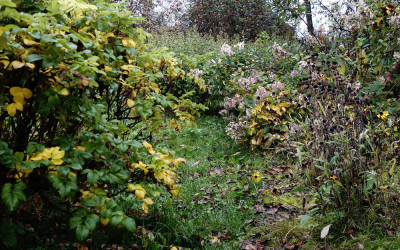Every autumn, gardens and landscapes become adorned with a rich tapestry of fallen leaves. To many, these leaves are simply seasonal debris to be gathered and discarded, and some find them really annoying – another task in the garden to sweep them up.
Yet beneath their seemingly lifeless exterior lies an invaluable resource – an organic material that enriches, aerates, and revitalises the soil. Decaying leaves are nature’s quiet alchemists, transforming waste into a substance that sustains life below ground.
They can also be useful to small animals that rely on these pockets of foliage to keep warm over the winter months.
The Science Behind Leaf Decay
Leaf decay is a natural process driven by microorganisms such as fungi, bacteria, and invertebrates. When leaves fall, their cellular structure begins to break down through microbial activity. Fungi initiate decomposition by secreting enzymes that dismantle complex organic compounds like lignin and cellulose. Bacteria then take over, digesting the simpler materials left behind. This decomposition releases essential nutrients – nitrogen, phosphorus, and potassium – back into the soil, replenishing its fertility and promoting biological diversity.
Temperature, moisture, and oxygen levels influence the rate of decay. In damp, well-aerated conditions, decomposition occurs swiftly, producing a crumbly, dark humus. In dry or compacted soils, however, decay slows, leading to a dense mat that can stifle plant roots. The balance between these elements determines whether leaves become a nutrient boon or a barrier to growth.
Nutrient Recycling and Soil Enrichment
As leaves decompose, they act as a natural fertiliser. The nutrients once locked within their tissues are returned to the earth, ready for uptake by plants. This cycle reduces the gardener’s dependence on synthetic fertilisers, fostering a more sustainable growing environment.
Leaf mould, a rich, earthy substance formed from fully decomposed leaves is particularly beneficial. Unlike compost, which is nutrient-heavy, leaf mould excels at improving soil structure and water retention. It enhances the soil’s capacity to hold moisture during dry spells while allowing excess water to drain freely during wet periods. This balance creates a stable habitat for beneficial organisms such as earthworms and mycorrhizal fungi, which further improve soil aeration and fertility.
Improving Soil Texture and Structure
The physical structure of soil determines how well plants can establish their roots and absorb nutrients. Adding decayed leaves introduces organic matter that loosens heavy clay soils and gives body to sandy soils. In compacted ground, leaf debris opens up microscopic channels, improving air flow and root penetration. Over time, these subtle changes create a loam-like consistency that supports robust, healthy growth.
Moreover, the humic acids produced during decomposition play a pivotal role in binding soil particles together. This aggregation reduces erosion, enhances moisture retention, and creates a resilient soil ecosystem capable of withstanding fluctuations in temperature and rainfall.
Mulching with Fallen Leaves
Using fallen leaves as mulch provides both immediate and long-term benefits. A layer of shredded leaves placed around plants and trees protects roots from extreme temperature shifts, suppresses weed growth, and conserves soil moisture. As the mulch decomposes, it slowly releases nutrients, feeding the plants it shelters.
For best results, leaves should be shredded before application. Whole leaves tend to mat together, restricting airflow and impeding water absorption. Shredding accelerates the decay process and ensures even coverage. Oak, beech, and maple leaves are particularly effective due to their balanced carbon-to-nitrogen ratios.
Composting and Leaf Mould Production
Gardeners can harness the power of leaf decay by creating dedicated leaf mould piles or incorporating leaves into compost heaps. When piled separately and left undisturbed, leaves gradually transform into leaf mould within one to two years. The result is a dark, friable material ideal for improving soil texture or top-dressing lawns.
Alternatively, combining leaves with nitrogen-rich materials such as grass clippings or kitchen scraps accelerates decomposition. The blend of carbon from the leaves and nitrogen from green waste creates the perfect environment for microbial activity. Turning the pile periodically introduces oxygen, preventing anaerobic conditions and speeding the process.
Environmental and Economic Benefits
Utilising decaying leaves reduces garden waste and lowers reliance on commercial soil conditioners and fertilisers. It supports biodiversity by creating habitats for insects, worms, and other decomposers. On a broader scale, retaining organic matter on-site prevents the unnecessary transport of green waste, cutting carbon emissions associated with its disposal.
Financially, the approach is both prudent and sustainable. By turning fallen leaves into soil-improving material, gardeners minimise expenditure while maintaining healthy, fertile ground. It is an elegant example of circular ecology – where nothing is wasted, and every stage of the natural cycle contributes to regeneration.
More than an annoyance
Decaying leaves are far more than seasonal litter; they are an ecological resource of immense value. When allowed to decompose naturally or used intentionally within the garden, they restore nutrients, refine soil structure, and sustain the intricate web of life beneath our feet. Embracing the humble leaf as a tool for soil enrichment transforms routine garden maintenance into an act of environmental stewardship. The next time the wind scatters autumn’s bounty across the ground, it may be worth pausing before reaching for the rake – nature, after all, has already begun the work of renewal.



